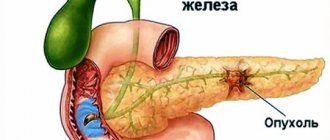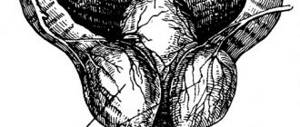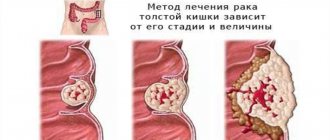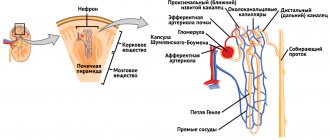One of the most dangerous and difficult to treat prostate diseases is cancer. Like any oncological disease, prostate cancer in men is quite difficult to detect at first, but yet it occurs in every seventh man. Nevertheless, this disease can be successfully fought.
Prostate cancer is a malignant neoplasm that arises from the epithelium of the alveolar cell elements of the prostate. This disease also has another name - carcinoma.
Causes of prostate cancer
Scientists have not yet identified the causes of this disease. However, there are a number of certain risk factors:
- Hormonal imbalance (sharp increase or decrease in testosterone levels).
- Age. The main risk zone includes people forty and older.
- Ecology. An unfavorable environmental environment contributes to the development of cancer of all types.
- Nutrition. Unbalanced consumption of animal fats provokes the onset of the disease. The absorption of vitamin A deteriorates, and with it beta-carotene, which protects a person from the development of tumors.
- Work in production. Chemical production, for example, work with cadmium welding or in the rubber industry.
- Heredity. The risk of the disease increases by 2 times if you have relatives who have had it.
Symptoms of the disease
A prostate tumor is quite insidious, since at the first stage of the disease it does not show any signs at all. As the tumor develops, damage occurs to the intestines and bladder. Symptoms associated with changes in the size of the prostate gland appear. She begins to put pressure on the bladder.
The tumor compresses the urinary tract where it passes through the prostate. As a result, the tumor makes urination difficult, painful and irregular. Urination becomes more frequent, the ability to “tolerate” decreases, and pain appears during the process. The feeling of the bubble being full is always present. There may be blood in the urine and semen.
When the disease develops to the last stage, metastases (spread of the disease to other parts of the body) initiate such unpleasant symptoms as:
- bone pain;
- lack of strength;
- anemia;
- significant weight loss for no reason;
- pulmonary cough;
- yellowness of the skin;
- lumbar pain.
The onset of symptoms does not occur immediately. They accumulate over many years. In addition, each of these signs may indicate completely different diseases. Diseases with similar symptoms may be adenoma or prostatitis. In any case, it is worth visiting a urologist.
Symptoms
The main signs of prostate carcinoma in men are very similar to the signs of adenoma (benign tumor) of the prostate. In the later stages of the disease, symptoms are as follows:
- pain;
- difficult painful urination;
- erectile dysfunction leading to impotence;
- blood in the urine (hematuria);
- frequent need to get up at night to urinate;
- a feeling of bladder fullness and a strong desire to go to the toilet;
- the stream of urine is weak, intermittent, there is a need to strain4
- feeling of a not completely empty bladder.
When, in advanced stages of cancer, metastases penetrate into nearby and distant organs and tissues, this causes constant pain and discomfort of various types:
- pain and non-union of fractures in metastatic areas of bones;
- frequent colds, viral diseases due to decreased immunity;
- pain in other metastatic organs;
- constipation;
- bowel movements mixed with blood and mucus;
- apathy and fatigue;
- hematuria;
- cough with bloody sputum;
- pyelonephritis, pain in the lumbar region;
- sudden weight loss;
- the skin becomes pale earthy in color.
Early symptoms
The sluggish course of the disease with the absence of visible symptoms at an early stage only increases its danger. Symptoms of prostate carcinoma at an early stage are almost impossible to notice, so men after 45 years of age must undergo an examination and tests. Early detection and treatment of the disease increases the patient's chances. Perhaps nothing serious will be discovered, but you need to make sure of this after the examination. You should be wary and consult a doctor if:
- at night you often have to get up to go to the toilet;
- the jet pressure is weak;
- emptying occurs strained with painful burning sensations.
Stages of prostate cancer development
- The tumor is still microscopic in size and therefore does not show any signs. Its presence at this stage can only be demonstrated by an increase in the level of specific prostate antigen (PSA) in the blood.
- The tumor develops and begins to increase in size, but still remains outside the boundaries of the prostate. It can be detected by palpation or ultrasound.
- The tumor spreads beyond the prostate organ, affecting neighboring organs. The neoplasm affects the seminal vesicles, bladder and rectum. Distant organs are not yet damaged.
- The malignant tumor reaches a significant size, and the number of metastases in organs distant from the prostate increases.
Stages
The generally accepted classification of carcinomas, which is used in European urology clinics, uses the Gleason scoring system: in it, stages are assessed according to the degree of malignancy. Low-aggressive cancer is scored 1 point, and highly aggressive cancer is scored 5 points. As a rule, if several foci occur in carcinoma, then histological material is taken from at least two large tumors and the research results are summarized to obtain a Gleason score. So, the minimum index is 2 points, the maximum is 10 points.
The next classification method is the Jewitt-Whitemore system, which serves to differentiate a tumor by size, damage to lymph nodes, and the presence of metastases. Degree of tumor spread:
- First stage A. Malignant cells practically do not differ from normal ones, the tumor is encapsulated, the course of the disease is asymptomatic.
- Second stage B. The tumor is encapsulated, is located within the organ, is not palpable rectally, tumor growth is observed, the PSA level is elevated, the course is asymptomatic.
- Third stage C. The tumor begins to extend beyond the gland, spreading to nearby lymph nodes, the tumor penetrates the bladder and urethra, making it difficult for urine to pass out.
- Stage four D. Metastatic tumor, elevated PSA level, extensive metastatic damage to regional lymph nodes, tissues, organs, there is a high probability of relapses after treatment.
Diagnosis of the disease
The doctor, based on the man’s complaints, draws up a picture of the disease. If there is a suspicion of cancer, then examination methods are selected that will confirm or refute this suspicion:
- The prostate is examined using the finger method. The organ is probed through the rectum, identifying the presence of suspicious lumps.
- Transrectal ultrasound (TRUS) is a research method by inserting an ultrasound device into the rectum.
- Biopsy for histology. Using a special puncture needle, which is inserted into the direct passage, the material is collected.
- Blood test for PSA (prostate specific antigen). A PSA level between 4 and 10 ng/mL is designated as the “gray zone.” It shows that you cannot be sure that you have prostate cancer, but you should get tested. A hidden form of leakage is possible. At the “advanced” stage of the disease, PSA is 10 ng/ml.
- Sometimes X-rays or studies using radioisotopes are used to clarify information.
- A computed tomography (CT) scan or magnetic resonance imaging (MRI) scan can further pinpoint the location of cancer that has spread beyond the prostate.
Age-specific values for the upper level of total prostate-specific antigen in blood serum are shown in the table.
| Age, years | Value, ng/ml |
| 40 – 49 | 2,5 |
| 50 – 59 | 3,5 |
| 60 – 69 | 4,5 |
| more than 70 | 6,5 |
How to detect cancer at an early stage?
For a long time, many men are unaware of the presence of a malignant neoplasm in the prostate gland. Only a random visit to a doctor helps identify negative changes.
Atypical prostate hyperplasia should alert the doctor and the patient. In this case, nodes form in the gland. Their cells are able to quickly change their structure and spread in the prostate gland. If treatment is not started on time, malignant formations will appear in the affected areas.
Particular attention is paid to patients with hyperplasia with malignancy. In this case, accelerated cell proliferation occurs in certain zones. Subsequently, they can become a tumor.
Small tumors are difficult to identify during examination and ultrasound. In this case, only an analysis to determine the PSA level will help identify negative changes.
PSA blood levels are normal in men
The disease at a late stage is much easier to diagnose. With a significant increase in tumor, the patient feels:
- increased fatigue;
- weakness;
- rise in body temperature;
- severe intoxication;
- pain during bowel movements;
- inability to pass urine.
Prostate cancer treatment methods
If prostate cancer is detected, treatment should begin as soon as possible.
Chemotherapy
It inhibits the development of cancer cells, but, unfortunately, also affects healthy ones. An alternative to chemistry today is targeted treatment. It consists of attacking cancer cells with highly specific monoclonal antibodies. This method keeps side effects to a minimum.
Use of hormones. Allows you to significantly slow down (and sometimes even stop) cell development. Rarely used as a separate method.
Brachytherapy
An iodine isotope is injected through a direct passage into the prostate gland using a special needle. Radioactive iodine acts precisely on cancer cells, since their location is determined down to the millimeter.
Main signs of violations
Signs of prostate cancer, despite the erased symptoms, can be determined by a man on his own. To do this, you need to carefully monitor the condition of the body, paying attention to the most minor symptoms.
Be attentive to changes in your body!
The main manifestations of the disease are identified, which should alert a man.
- The patient has difficulty urinating. There is a frequent urge to go to the toilet, which intensifies in the evening and at night. In this case, urine excretion occurs in small quantities. Sometimes a few drops come out. After visiting the toilet, a man feels his bladder full. Patients often experience pain and cramps during the outflow of urine.
- Acute urinary retention is often caused by hematuria. During this process, blood clots form in the bladder, which interfere with the outflow of fluid.
- With the development and growth of a malignant neoplasm in the prostate gland, pain occurs. It is localized in the lumbar region, perineum, anus and sacrum.
Pain in the lower abdomen
- The patient develops renal failure. The body weakens, and the mouth is constantly dry. The process is accompanied by aching pain in the lower back. As a result, vomiting, headaches and exhaustion may occur.
- Changes in the genitourinary system and excretory organs are provoked by the spread of cancer cells through the seminal vesicles. When the ureter is compressed in the area of the bladder, the pressure spreads to the pelvis. As a result, this leads to impaired kidney function.
At an early stage, it is difficult for a doctor to determine the presence of disorders in a man’s body. Therefore, the patient needs to be tested to determine the level of prostate-specific antigen in the blood, which is a tumor marker for prostate cancer.
A blood test will show the presence of prostate cancer
Prostate cancer prognosis
If cancer is detected at an early stage (before metastases develop), the patient’s complete recovery is likely, that is, the prognosis is favorable.
Treatment will easily get rid of the tumor, help maintain potency and avoid problems with urination. A man can live his old life and go to work. Life expectancy after recovery is not limited by time frames.
If this moment is missed, then the person’s condition is supported by various manipulations, but a solution to the problem may sometimes never be found. When organs are damaged by metastases, the prognosis is unfavorable. Treatment is difficult and lengthy. The result depends on the experience of the attending physicians and the individual characteristics of the patient.
Most patients cured of stage 2 live more than 10 years. Starting treatment at the third stage prolongs the life of 50% of patients by up to five years. At the fourth stage of cancer, such a prognosis seems possible only for a fifth of cured patients. But sometimes a miracle happens with a combination of treatment methods, great faith and love for life.
Forecast
Which doctor can give a prognosis for prostate cancer depends on the stage of the newly diagnosed disease. Detection in the early stages increases the patient’s chances of completely defeating the disease. In Germany, for example, special attention is paid to this disease; men undergo regular examinations and only 18% are diagnosed with prostate cancer. In America, 80% of men who were given a similar diagnosis were successfully cured of cancer. A positive prognosis depends on how much attention you pay to your health.
Prevention of prostate cancer
A method has not yet been invented that completely prevents the development of prostate cancer. Still, the risk can be significantly reduced by following some rules:
- Healthy food;
- eliminate bad habits (smoking and alcohol abuse);
- exercise. As an alternative, morning exercises and walks in the park are suitable;
- get enough sleep (at least 7 hours of sleep);
- establish regular sex life and do not forget about contraception;
- do not neglect examinations, especially after 50 years. Once every two years (and more often if you have prostatitis), take special tests.
The right approach to your own health is the key to a long and happy life.












